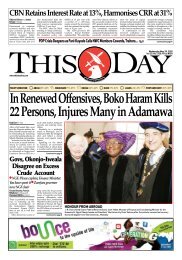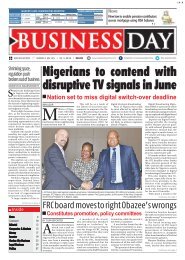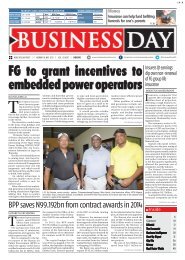business0515
You also want an ePaper? Increase the reach of your titles
YUMPU automatically turns print PDFs into web optimized ePapers that Google loves.
32 BUSINESS DAY<br />
Friday 15 May 2015<br />
Harvard<br />
ManagementDigest<br />
Business<br />
Review<br />
Two keys to sustainable social enterprise<br />
ROGER L. MARTIN AND SALLY R. OSBERG<br />
Social entrepreneurship has<br />
emerged over the past several<br />
decades as a way to identify and<br />
bring about potentially transformative<br />
societal change. A hybrid<br />
of government intervention and pure<br />
business entrepreneurship, social ventures<br />
can address problems that are too narrow<br />
in scope to spark legislative activism or to<br />
attract private capital.<br />
To succeed, these ventures must adhere<br />
to both social goals and stiff financial<br />
constraints. Typically, the aim is to benefit<br />
a specific group of people, permanently<br />
transforming their lives by altering a prevailing<br />
socioeconomic equilibrium that<br />
works to their disadvantage.<br />
The endeavor must also be financially<br />
sustainable. Otherwise the new<br />
socioeconomic equilibrium will require a<br />
constant flow of subsidies from taxpayers<br />
or charitable givers, which are difficult to<br />
guarantee indefinitely. To achieve sustainability,<br />
an enterprise’s costs should fall as<br />
the number of its beneficiaries rises.<br />
Over the past 15 years we have studied<br />
successful social entrepreneurs up close<br />
through our work for the Skoll Foundation,<br />
established in 1999 by the Internet<br />
entrepreneur Jeffrey Skoll. Each year the<br />
foundation confers the Skoll Award for<br />
Social Entrepreneurship (SASE) on a small<br />
number of people. More than 100 social<br />
entrepreneurs representing 91 organizations<br />
have received Skoll awards to date.<br />
In studying these leaders and their<br />
ventures, we have found that they all focus<br />
on changing two features of an existing<br />
system - the economic actors involved and<br />
the enabling technology applied.<br />
THE ACTORS<br />
Social and economic problems often<br />
reflect an imbalance of power among<br />
the economic actors involved. India’s<br />
handwoven-carpet industry offers a prime<br />
example. In the early 1980s the children’s<br />
rights activist Kailash Satyarthi, joint<br />
winner with Malala Yousafzai of the 2014<br />
Nobel Peace Prize, saw that poor children<br />
were easy prey for labor brokers who<br />
recruited workers for a number of Indian<br />
industries, including carpet weaving. Captured<br />
by these middlemen, the children<br />
were sold to business owners who forced<br />
them to work 12 or more hours a day under<br />
brutal conditions. Three groups of players<br />
- owners, labor brokers and retailers<br />
- dominated the country’s handmade-rug<br />
industry, their interlocking interests perpetuating<br />
a particularly ugly equilibrium<br />
that benefited them by exploiting children.<br />
In situations like this, we have observed,<br />
social entrepreneurs aim to transform<br />
the equilibrium by adding new actors<br />
to an existing system. These actors fall into<br />
two categories: customers, whose role is to<br />
shift the power balance; and government,<br />
whose role is to alter the economics.<br />
- Customers and power. Satyarthi<br />
began his career in activism primarily<br />
through advocacy and organizing raids<br />
on companies, in the hope that he could<br />
raise awareness of child exploitation.<br />
Eventually he discovered that what could<br />
make a real difference was enlightened<br />
consumers who would refuse to buy rugs<br />
that had been made with slave labor. In<br />
the mid-1990s he launched Rugmark<br />
(now GoodWeave International) as the<br />
first voluntary labeling scheme to certify<br />
rugs produced without child labor in South<br />
Asia. Today GoodWeave operates globally.<br />
More than 130 carpet importers and retailers<br />
- including Target - have signed on,<br />
pledging to source woven rugs that have<br />
been certified by GoodWeave.<br />
- Government and economics. A number<br />
of successful social entrepreneurs have<br />
generated a better equilibrium by moving<br />
government from the sidelines to a far<br />
more productive place in the system. The<br />
Amazon Conservation Team tackled the<br />
problem of Amazon basin deforestation<br />
by rendering Brazil’s government a more<br />
effective actor in a system that previously<br />
pitted primarily indigenous peoples<br />
against the loggers, ranchers and miners<br />
who were razing millions of hectares of<br />
forest in the basin - often illegally. ACT’s<br />
core innovation was to equip tribal peoples<br />
with handheld GPS devices and train them<br />
to chart their ancestral lands. The resulting<br />
maps enabled them to advocate more<br />
effectively for their own interests by supplying<br />
the government with information<br />
needed for rain forest conservation.<br />
THE TECHNOLOGY<br />
Economic and social agents use<br />
structures, business models and tools to<br />
achieve their desired ends in an existing<br />
equilibrium, which often is unjust and<br />
suboptimal. A second way, therefore, to<br />
effect change is to dramatically improve<br />
a system’s technology while leaving the<br />
current actors in place:<br />
- Replace a key technology with a<br />
lower-cost one. A number of SASE winners<br />
have succeeded by identifying a lower<br />
cost technology that can substitute for a<br />
prevailing standard in a given function<br />
or product component. In Africa, mothers2mothers<br />
trains “mentor mothers” to<br />
monitor HIV-positive pregnant women.<br />
Such help has been shown to increase<br />
the latter’s adherence to the demanding<br />
treatment regimens required to increase<br />
their chances of delivering healthy, HIVnegative<br />
babies.<br />
Create a new enabling technology.<br />
Social entrepreneurs also succeed by sup-<br />
plying or creating a new technology that<br />
allows users to do things they could not<br />
previously do. Before Matt Flannery and<br />
Jessica Jackley created the Kiva platform,<br />
it was nearly impossible for small-scale<br />
lenders in wealthy countries to lend to<br />
small-scale borrowers in poor countries.<br />
The Kiva platform provides a technology<br />
to break through these barriers, enabling<br />
microlenders worldwide to make loans as<br />
small as $25 to microborrowers in poor<br />
countries. Transaction costs on both sides<br />
have plummeted as more lenders and<br />
borrowers have begun to use the platform.<br />
Kiva is on track to facilitate more than<br />
$1 billion in microloans within the next<br />
couple of years.<br />
- Repurpose an existing enabling technology.<br />
The SASE winner Victoria Hale, a<br />
former pharmaceutical company scientist<br />
and U.S. Food and Drug Administration<br />
staffer, created the Institute for OneWorld<br />
Health (iOWH) to scour pharmaceutical<br />
company shelves for drugs deemed<br />
unsuitable for developed world markets<br />
and incapable of generating profits in the<br />
developing world. Hale identified a drug<br />
that had been fully developed but was<br />
no longer in production, paromomycin,<br />
which she believed could be used to cure<br />
leishmaniasis (black fever). Clinical trials<br />
in India proved her right. Eliminating the<br />
huge costs of drug development enabled<br />
iOWH to persuade the Indian government<br />
to make paromomycin available, turning<br />
“prohibitively expensive” into “life-saving”<br />
for those afflicted.<br />
To be sure, pursuing a social goal while<br />
being constrained by the requirement of<br />
financial sustainability is difficult. Yet the<br />
evidence we see from our work at the Skoll<br />
Foundation shows that many entrepreneurs<br />
are succeeding, in settings all over<br />
the world, at creating scalable social ventures<br />
to transform unhappy circumstances<br />
for a great number of people. The clearly<br />
emerging pattern in their successes can<br />
serve as a valuable road map for others,<br />
thereby speeding society’s journey toward<br />
a better, fairer future.<br />
(Roger L. Martin is the former dean of<br />
the Rotman School of Management at the<br />
University of Toronto and a co-author of<br />
“Playing to Win” and a director of the Skoll<br />
Foundation. Sally R. Osberg is the president<br />
and CEO of the Skoll Foundation.)<br />
c<br />
2015 Harvard Business School Publishing Corp. Distributed by The New York Times Syndicate
















